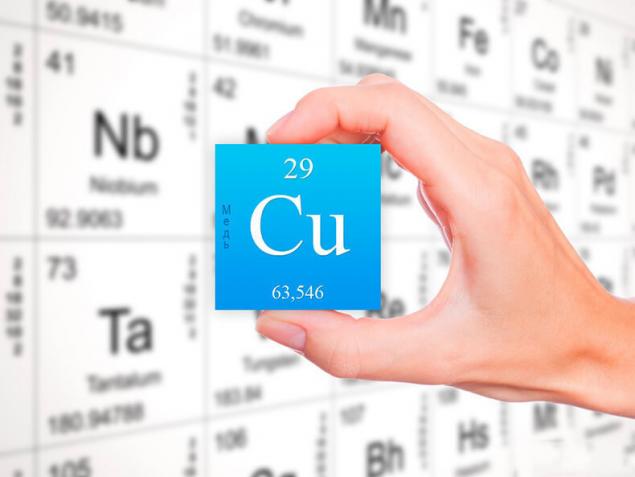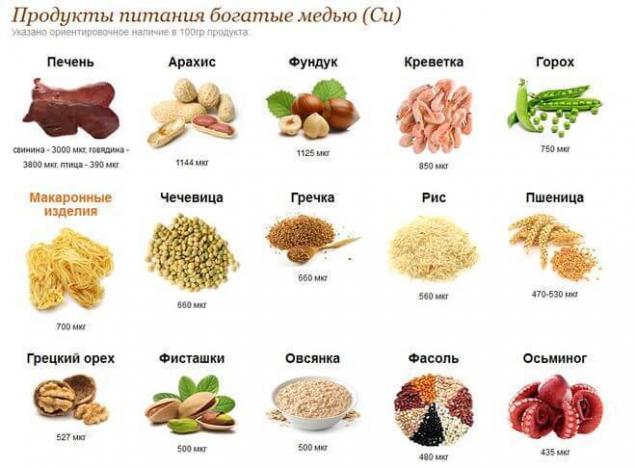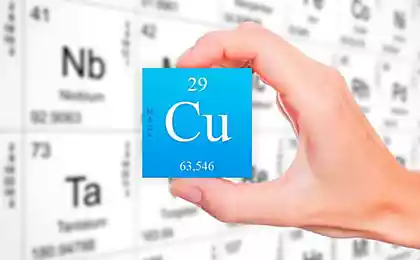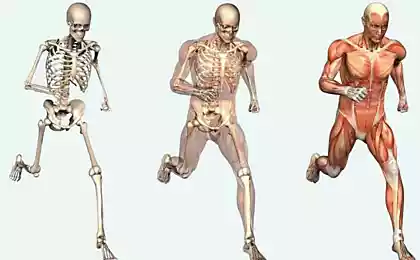446
Copper is a mineral against gray hair
In the human body, copper is involved in the breathing process of the tissues in the processes of anabolism (the synthesis of new structures and materials), synthesis of hemoglobin and other galatoboureko, pigments of the skin, hair, eyes, affects the functioning of the endocrine glands.
The importance of copper for the human body known since ancient times. So, the ancient Greek physician and philosopher Empedocles worn copper sandals, considering that they provide him the mental alertness and imagination. Sina's "Canon of medicine" (1020 g) prescribed copper powder for fractures and recommended to bind the copper plates to purulent wounds. In the same way, behave the Khanty and Nenets in Tyumen region, infusing the water on the powder of metallic copper, which you drink for fractures. In Syria and Egypt the newborn for the prevention of rickets and epilepsy wear copper bracelets. For this reason, the old believers of the Urals and Siberia prefer to wear copper crosses on the lace.

The daily requirement of the human body – from 1 to 7 mg (as recommended by the world health organization (who) the daily requirement of copper for adults is 1.5 mg). Copper deficiency in the body may develop if insufficient intake of this element (1 mg/day or less).
In the gastrointestinal tract is absorbed up to 95% of copperentering the body (and stomach the amount of its maximum), then in the duodenum, the jejunum and the ileum. Better absorbed by the body of bivalent copper. In the blood copper is bound with serum albumin (12-17%), amino acids histidine, threonine, glutamine (10-15%), transport protein transmarina (12-14%) and ceruloplasmin (up to 60-65%).
Copper penetrates into all cells, tissues and organs. The maximum concentration of copper observed in the liver, kidney, brain, blood, but copper can be detected in other organs and tissues.
Lead role in copper metabolism plays liver, because there is synthesized the protein ceruloplasmin, which has enzymatic activity and is involved in the regulation of homeostasis of copper. Besides ceruloplasmin participates in oxidation of bivalent iron into trivalent, because only in this the form of iron available to the body.
The biological role in the human body.
Copper plays an important role in biosynthesis of heme and, consequently, hemoglobin. Therefore, its failure, as well as iron can lead to anemia. Copper is included in the structure of cytochrome – terminal enzyme of the respiratory chain of mitochondria and is, therefore, necessary for processes of energy generation in the cell.
Copper plays an important role in antioxidant defense of the organism, because together with the zinc enters into the structure of tissue antioxidant enzyme – superoxide dismutase and antioxidant protein of blood plasma – ceruloplasmin, which is the carrier of this metal. Copper has anti-inflammatory and antiseptic properties (possibly due to antioxidant action). Regulates the metabolism of catecholamines, serotonin, tyrosine, melanin, enhances insulin activity and more complete utilization of carbohydrates. Necessary for growth and reproduction, is part of the melanin pigment.
This trace mineral involved in the formation of the structure of connective tissue proteins – collagen and elastin, which are structural components of bone and cartilage, skin, lungs, blood vessel walls. Therefore, copper deficiency can lead to the formation of aneurysms of the aorta and cerebral vessels. For the same reason, copper deficiency leads to bone demineralization and osteoporosis.
Copper participates in the formation of myelin sheaths of nerve degeneration, which leads to multiple sclerosis and other serious disorders of the nervous system.
Synergists and antagonists of copper.
Iron, zinc, ascorbic acid, tannins, antacids and carbohydrates affect the bioavailability of copper, if they are included in the diet in large quantities. To a greater or lesser extent, the levels of copper in diet can in turn, affect the metabolism of some of these nutrients.
Copper deficiency alters iron metabolism and excess iron in the form of inorganic salts leads to symptoms of copper deficiency.
Depletion of copper has been observed in humans, long-term taking large amounts of zinc and molybdenum.
There is a physiological antagonism of copper with molybdenum and sulfate sulfur, and manganese, zinc, lead, strontium, cadmium, calcium, silver.
In turn, copper can inhibit the body's absorption of iron, cobalt, zinc, molybdenum, vitamin a, Oral contraceptives, hormonal agents, drugs cortisone contribute to increased excretion of copper from the body.
Daily supplementation of 1500 mg of ascorbic acid leads to a decrease in the concentration of ceruloplasmin, which carries copper. Absorption of copper does not interfere 600 mg of ascorbic acid, but a decrease of ceruloplasmin, and probably can be abused, it oxidasational activity.
In experimental studies found that the type consumed in the diet carbohydrates affect the degree and severity of copper deficiency. Especially the adverse effects of sucrose and fructose.
Cobalt (moderate physiological doses) increase the absorption of copper by the body.
Signs of deficiency of copper.
One of the earliest signs of copper deficiency is osteoporosis (copper plays a significant role in the formation of collagen, a principal protein that form bone, skin and connective tissue), graying and baldness.
Insufficiency of copper in the body may cause growth retardation, anemia, depigmentation of hair (graying) and partial baldness, weakness, reduced respiratory function, skin sores, loss of appetite and consequently, weight loss, atrophy of the heart muscle, decrease in hemoglobin and red blood cell count.
The copper content is reduced in diabetes.Reducing the content and emotional stress, psychasthenia, epilepsyand, therefore, possible in the treatment of nervous and mental diseases drugs and plants containing copper. In this regard, the malachite products can be considered as a means of calming the mental state, because the malachite includes copper.
The copper content is increased in epilepsy, hepatitis, cirrhosis, anemia, leukemia and various infectious diseases (scarlet fever, diphtheria, tuberculosis, meningitis).
There is a direct correlation between the level of copper in the blood, and increased body temperature as a result of inflammation. On the diagnostic significance of the increase in the copper content comparable even with the definition in ESR.
The main symptoms of excess copper: functional disorders of the nervous system (memory loss, depression, insomnia); allergic dermatitis, increased risk of atherosclerosis, liver and kidney damage, hemolysis of erythrocytes, the appearance of hemoglobin in the urine, anemia, liver damage with cirrhosis and secondary brain damage-related disorders of copper metabolism and proteins (Wilson's disease – a disease associated with accumulation of copper in liver and other tissues).
The copper content in the liver is increased in cirrhosis, very high levels observed in primary biliary cirrhosis and atresia of the biliary tract. In these conditions to a greater extent recommended the appointment of chelating drugs than the limit of copper in the diet.

Excess intake of copper by man leads to excessive deposition of this element in the brain tissue, skin, liver, pancreas and myocardium.
Copper needed: in hyperlipidemia, osteoporosis, anemia, to strengthen hair, normal functioning of the nervous system and joints, diseases of the lungs, inflammation, gangrene, diabetes and disease.
Food sources of copper: nuts and seeds: peanuts, poppy seeds, macadamia nuts, almonds, Brazilian nuts, walnuts, pine nuts, sunflower seeds, pumpkin seeds, pistachio nuts, especially cashews, sesame seeds, hazelnuts; vegetable
oil: pumpkin seed oil; dried fruits: raisins, dried figs, dried apricots, dates, prunes;
cereal, especially buckwheat, corn, oats, millet, soft wheat, durum wheat, long grain white rice, round grain rice, white rice, unpolished rice, rice wild, rye, barley;
legumes (beans, peas, soybeans, beans, lentils);
tea, coffee;
vegetables: ginger, broccoli, kohlrabi, potatoes, leafy vegetables, parsnips, parsley, radishes, beets, asparagus, tomatoes, Jerusalem artichoke, pumpkin, horseradish, garlic;
herbs: Basil, coriander (cilantro), green onions, leeks, chives, parsley, celery greens, fennel, green garlic, sorrel;
fruits: avocado, apricots, quince, citrus fruits (especially oranges and lemon peel), cherries, pomegranates, pears, strawberries, kiwi, gooseberry, raspberry, mango, sea buckthorn, black currant, persimmon, cherry, mulberry;
mushrooms: white mushrooms, oyster mushrooms, chanterelles, mushrooms, mushrooms, mushrooms.
Vital CHROME: say goodbye to diabetes and obesity!Emotional causes of disease
To foods rich in copper are liver and kidney, salmon, shrimp, lobster, crayfish and other products MorI, in particular laminaria (sea cabbage). To use these products are recommended separately.published
Source: www.pharmacognosy.com.ua/index.php/makro-i-mikro-chudesa/med-mineral-protiv-sedykh-volos
The importance of copper for the human body known since ancient times. So, the ancient Greek physician and philosopher Empedocles worn copper sandals, considering that they provide him the mental alertness and imagination. Sina's "Canon of medicine" (1020 g) prescribed copper powder for fractures and recommended to bind the copper plates to purulent wounds. In the same way, behave the Khanty and Nenets in Tyumen region, infusing the water on the powder of metallic copper, which you drink for fractures. In Syria and Egypt the newborn for the prevention of rickets and epilepsy wear copper bracelets. For this reason, the old believers of the Urals and Siberia prefer to wear copper crosses on the lace.

The daily requirement of the human body – from 1 to 7 mg (as recommended by the world health organization (who) the daily requirement of copper for adults is 1.5 mg). Copper deficiency in the body may develop if insufficient intake of this element (1 mg/day or less).
In the gastrointestinal tract is absorbed up to 95% of copperentering the body (and stomach the amount of its maximum), then in the duodenum, the jejunum and the ileum. Better absorbed by the body of bivalent copper. In the blood copper is bound with serum albumin (12-17%), amino acids histidine, threonine, glutamine (10-15%), transport protein transmarina (12-14%) and ceruloplasmin (up to 60-65%).
Copper penetrates into all cells, tissues and organs. The maximum concentration of copper observed in the liver, kidney, brain, blood, but copper can be detected in other organs and tissues.
Lead role in copper metabolism plays liver, because there is synthesized the protein ceruloplasmin, which has enzymatic activity and is involved in the regulation of homeostasis of copper. Besides ceruloplasmin participates in oxidation of bivalent iron into trivalent, because only in this the form of iron available to the body.
The biological role in the human body.
Copper plays an important role in biosynthesis of heme and, consequently, hemoglobin. Therefore, its failure, as well as iron can lead to anemia. Copper is included in the structure of cytochrome – terminal enzyme of the respiratory chain of mitochondria and is, therefore, necessary for processes of energy generation in the cell.
Copper plays an important role in antioxidant defense of the organism, because together with the zinc enters into the structure of tissue antioxidant enzyme – superoxide dismutase and antioxidant protein of blood plasma – ceruloplasmin, which is the carrier of this metal. Copper has anti-inflammatory and antiseptic properties (possibly due to antioxidant action). Regulates the metabolism of catecholamines, serotonin, tyrosine, melanin, enhances insulin activity and more complete utilization of carbohydrates. Necessary for growth and reproduction, is part of the melanin pigment.
This trace mineral involved in the formation of the structure of connective tissue proteins – collagen and elastin, which are structural components of bone and cartilage, skin, lungs, blood vessel walls. Therefore, copper deficiency can lead to the formation of aneurysms of the aorta and cerebral vessels. For the same reason, copper deficiency leads to bone demineralization and osteoporosis.
Copper participates in the formation of myelin sheaths of nerve degeneration, which leads to multiple sclerosis and other serious disorders of the nervous system.
Synergists and antagonists of copper.
Iron, zinc, ascorbic acid, tannins, antacids and carbohydrates affect the bioavailability of copper, if they are included in the diet in large quantities. To a greater or lesser extent, the levels of copper in diet can in turn, affect the metabolism of some of these nutrients.
Copper deficiency alters iron metabolism and excess iron in the form of inorganic salts leads to symptoms of copper deficiency.
Depletion of copper has been observed in humans, long-term taking large amounts of zinc and molybdenum.
There is a physiological antagonism of copper with molybdenum and sulfate sulfur, and manganese, zinc, lead, strontium, cadmium, calcium, silver.
In turn, copper can inhibit the body's absorption of iron, cobalt, zinc, molybdenum, vitamin a, Oral contraceptives, hormonal agents, drugs cortisone contribute to increased excretion of copper from the body.
Daily supplementation of 1500 mg of ascorbic acid leads to a decrease in the concentration of ceruloplasmin, which carries copper. Absorption of copper does not interfere 600 mg of ascorbic acid, but a decrease of ceruloplasmin, and probably can be abused, it oxidasational activity.
In experimental studies found that the type consumed in the diet carbohydrates affect the degree and severity of copper deficiency. Especially the adverse effects of sucrose and fructose.
Cobalt (moderate physiological doses) increase the absorption of copper by the body.
Signs of deficiency of copper.
One of the earliest signs of copper deficiency is osteoporosis (copper plays a significant role in the formation of collagen, a principal protein that form bone, skin and connective tissue), graying and baldness.
Insufficiency of copper in the body may cause growth retardation, anemia, depigmentation of hair (graying) and partial baldness, weakness, reduced respiratory function, skin sores, loss of appetite and consequently, weight loss, atrophy of the heart muscle, decrease in hemoglobin and red blood cell count.
The copper content is reduced in diabetes.Reducing the content and emotional stress, psychasthenia, epilepsyand, therefore, possible in the treatment of nervous and mental diseases drugs and plants containing copper. In this regard, the malachite products can be considered as a means of calming the mental state, because the malachite includes copper.
The copper content is increased in epilepsy, hepatitis, cirrhosis, anemia, leukemia and various infectious diseases (scarlet fever, diphtheria, tuberculosis, meningitis).
There is a direct correlation between the level of copper in the blood, and increased body temperature as a result of inflammation. On the diagnostic significance of the increase in the copper content comparable even with the definition in ESR.
The main symptoms of excess copper: functional disorders of the nervous system (memory loss, depression, insomnia); allergic dermatitis, increased risk of atherosclerosis, liver and kidney damage, hemolysis of erythrocytes, the appearance of hemoglobin in the urine, anemia, liver damage with cirrhosis and secondary brain damage-related disorders of copper metabolism and proteins (Wilson's disease – a disease associated with accumulation of copper in liver and other tissues).
The copper content in the liver is increased in cirrhosis, very high levels observed in primary biliary cirrhosis and atresia of the biliary tract. In these conditions to a greater extent recommended the appointment of chelating drugs than the limit of copper in the diet.

Excess intake of copper by man leads to excessive deposition of this element in the brain tissue, skin, liver, pancreas and myocardium.
Copper needed: in hyperlipidemia, osteoporosis, anemia, to strengthen hair, normal functioning of the nervous system and joints, diseases of the lungs, inflammation, gangrene, diabetes and disease.
Food sources of copper: nuts and seeds: peanuts, poppy seeds, macadamia nuts, almonds, Brazilian nuts, walnuts, pine nuts, sunflower seeds, pumpkin seeds, pistachio nuts, especially cashews, sesame seeds, hazelnuts; vegetable
oil: pumpkin seed oil; dried fruits: raisins, dried figs, dried apricots, dates, prunes;
cereal, especially buckwheat, corn, oats, millet, soft wheat, durum wheat, long grain white rice, round grain rice, white rice, unpolished rice, rice wild, rye, barley;
legumes (beans, peas, soybeans, beans, lentils);
tea, coffee;
vegetables: ginger, broccoli, kohlrabi, potatoes, leafy vegetables, parsnips, parsley, radishes, beets, asparagus, tomatoes, Jerusalem artichoke, pumpkin, horseradish, garlic;
herbs: Basil, coriander (cilantro), green onions, leeks, chives, parsley, celery greens, fennel, green garlic, sorrel;
fruits: avocado, apricots, quince, citrus fruits (especially oranges and lemon peel), cherries, pomegranates, pears, strawberries, kiwi, gooseberry, raspberry, mango, sea buckthorn, black currant, persimmon, cherry, mulberry;
mushrooms: white mushrooms, oyster mushrooms, chanterelles, mushrooms, mushrooms, mushrooms.
Vital CHROME: say goodbye to diabetes and obesity!Emotional causes of disease
To foods rich in copper are liver and kidney, salmon, shrimp, lobster, crayfish and other products MorI, in particular laminaria (sea cabbage). To use these products are recommended separately.published
Source: www.pharmacognosy.com.ua/index.php/makro-i-mikro-chudesa/med-mineral-protiv-sedykh-volos























